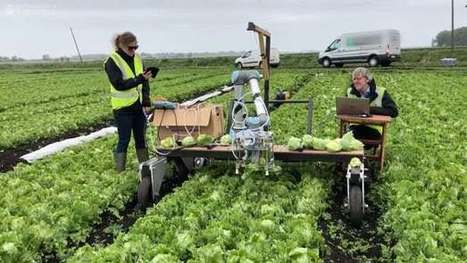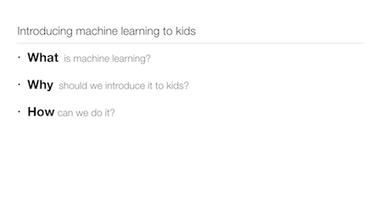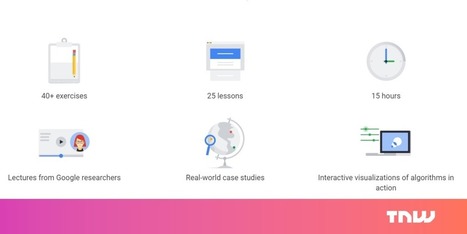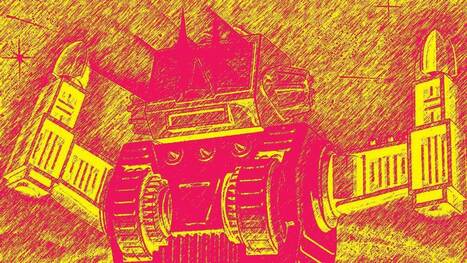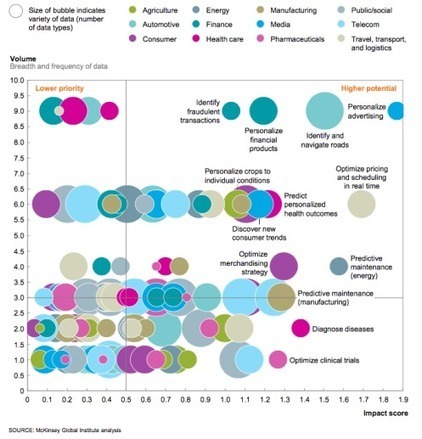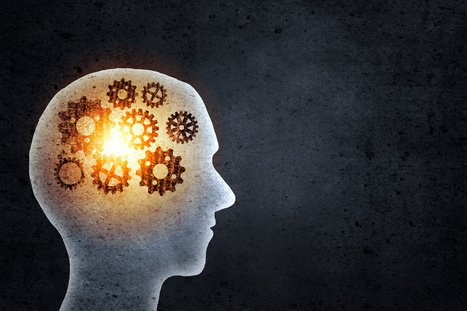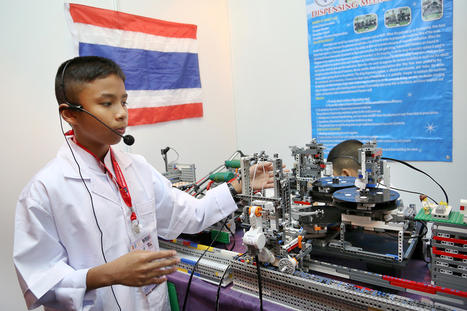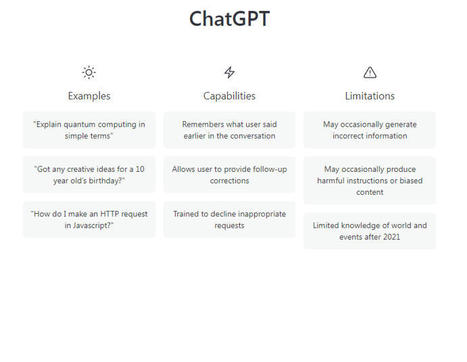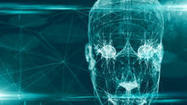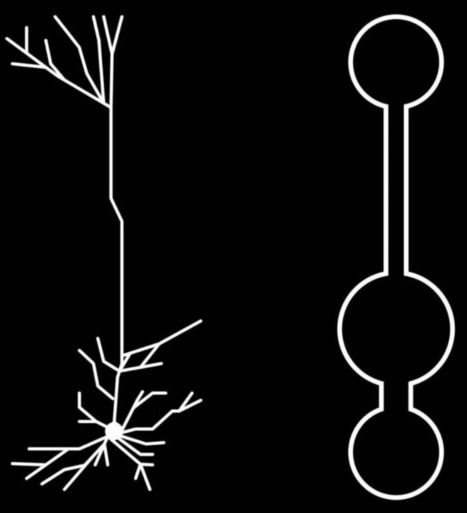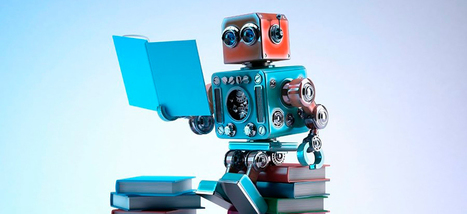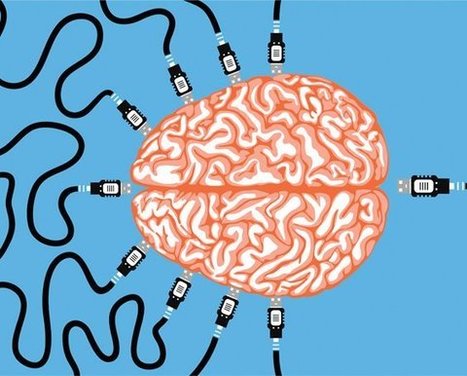 Your new post is loading...
 Your new post is loading...
Aunque hace años que se viene hablando de inteligencia artificial o de conceptos relacionados como el machine learning o el deep learning, ha sido en los dos últimos años, y especialmente en 2022, cuando el gran público ha visto a qué nos enfrentamos cuando hablamos de inteligencia artificial. Y de lo mucho que puede hacer por nosotros. En prácticamente cualquier ámbito.
Via Gumersindo Fernández
"Music streaming company Spotify is a prime example of an AI Native business. In this post, you'll learn what that means and why it should matter to you ..."
Via Leona Ungerer
Research report: The impact of AI, machine learning, automation and robotics on the information profession The purpose of this independent research is to help our professional community to understand how AI, machine learning, process automation and robotics are either already impacting the daily work of healthcare information professionals or likely to do so in the near future. In it author Dr Andrew Cox from Sheffield University, calls for a joined-up and coherent response from information professionals, enabling us to maximise the benefits of AI, machine learning, automation and robotics for information users while mitigating the emerging risks. The full research report, published by CILIP with the support of Health Education England, sets out a detailed and methodical analysis of the challenges and opportunities presented by this new generation of technologies. Report at: https://drive.google.com/file/d/19gWoLV_rSP1qKS9Z8KOoorRAQuHmFN4u/view
Via Elizabeth E Charles
Engineers from the University of Cambridge have developed a vegetable-picking robot that can autonomously identify and harvest iceberg lettuce, one of the more manually demanding crops for human pickers. Vegebot was trained using a machine-learning algorithm that helped it distinguish healthy lettuces ready for harvest, in a variety of different weather conditions.
Via John Evans
"This morning I want to talk to you about machine learning. In particular, I want to talk with you about machine learning in the context of education and how it could be introduced in the classroom."
Via John Evans
A small, family-owned grocery store in the heart of a downtown district has been providing goods to their community for over ten years. Customers come and go, and products fly off the shelves in waves. For the last two years, the store has seen a decline in sales and wonders if they will be able to weather the latest storm of dropping sales and over-bloated inventory. The owner relies on his intuition, but lately has noticed that his business is running inefficiently.
Via Elizabeth E Charles
Google really wants you to learn how to develop AI. It's offering the same course it gives to company engineers free to everyone now.
Via John Evans
New tools don’t always promote efficiency.
Software doesn’t always end up being the productivity panacea that it promises to be. As its victims know all too well, “death by PowerPoint,” the poor use of the presentation software, sucks the life and energy out of far too many meetings. And audit after enterprise audit reveals spreadsheets rife with errors and macro miscalculations. Email and chat facilitate similar dysfunction; inbox overload demonstrably hurts managerial performance and morale. No surprises here — this is sadly a global reality that we’re all too familiar with.
So what makes artificial intelligence/machine learning (AI/ML) champions confident that their technologies will be immune to comparably counterproductive outcomes? They shouldn’t be so sure. Digital empowerment all too frequently leads to organizational mismanagement and abuse. The enterprise history of personal productivity tools offers plenty of unhappy litanies of unintended consequences. For too many managers, the technology’s costs often rival its benefits.
It’s precisely because machine learning and artificial intelligence platforms are supposed to be “smart” that they pose uniquely challenging organizational risks. They are likelier to inspire false and/or misplaced confidence in their findings; to amplify or further entrench data-based biases; and to reinforce — or even exacerbate — the very human flaws of the people who deploy them.
Via Miloš Bajčetić
One of the issues I have with so many education technology projects, especially in the area of OER, is the reduction of the education problem to a search or discoverability problem. That's mostly what's happening here, and mostly how the application of machine learning to education is characterized generally. The holy grail of these applications seems to be Netflix. But we don't want to simply watch or consume learning resources, we want to do things and create things. But even thinking is treated as a search problem in this article: "If you are thinking about a topic, the machine can say, 'well based on that, have you thought about x?'" No, no, that's not how we think and learn.
Via Miloš Bajčetić
Those who understand learning and work with young people know that in an uncertain world of rapid change we urgently need to be helping learners to take risks, to work in teams, to develop a greater understanding of the way systems and societies work, and to become more creative. Fundamentally, these things have been washed out of the system in favour of a ‘learn fact, repeat fact’ model. To get the best out of this technology in the future, educators need to turn the current systems upside down. In previous technology developments in education – such as multimedia, whiteboards or the internet – initially, most worried that they would upset the world they were used to and feared for their jobs. Only a few imagined how these technologies could change the world and make things better. In reality, new technologies are typically highjacked to inappropriately maintain the status quo and end up powering the exam sausage factory. Moving forward into 2017, it is not the tech itself that needs to change. In most aspects of our lives, technology has made significant changes (for good and bad), but in education, particularly schools, there is still stubborn resistance. Learn more / En savoir plus / Mehr erfahren: https://gustmees.wordpress.com/2015/04/13/dos-and-donts-adapting-to-21st-century-education/ https://gustmees.wordpress.com/2015/07/19/learning-path-for-professional-21st-century-learning-by-ict-practice/ https://gustmees.wordpress.com/2015/12/27/what-are-the-best-ways-of-teaching-and-learning-ideas-and-reflections/
Via Gust MEES
By Ron Drabkin - Machine learning will be steadily adopted in a variety of educational technology tools. How will that affect you?
Via Marta Torán
A short video from the University of Oxford explains the concept of machine learning.
Via Elizabeth E Charles
|
Por Carlos Bravo Reyes Desde hace años es conocido el empleo de la inteligencia artificial, en numerosos procesos para mejorar la vida d
Via Juan Jesús Baño Egea
Machine learning helps teachers or instructors to have a thorough understanding of a student's performance.
Via Marta Torán
The New York Technical Services Librarians, an organization that has been active since 1923 – imagine all that has happened in tech services since 1923! – invited me to give a talk about bias in algorithms. They quickly got a recording up on their site and I am, more slowly, providing the transcript. Thanks for the invite and all the tech support, NYTSL! The Bigot in the Machine: Bias in Algorithmic Systems Abstract: We are living in an “age of algorithms.” Vast quantities of information are collected, sorted, shared, combined, and acted on by proprietary black boxes. These systems use machine learning to build models and make predictions from data sets that may be out of date, incomplete, and biased. We will explore the ways bias creeps into information systems, take a look at how “big data,” artificial intelligence and machine learning often amplify bias unwittingly, and consider how these systems can be deliberately exploited by actors for whom bias is a feature, not a bug. Finally, we’ll discuss ways we can work with our communities to create a more fair and just information environment. .
Via Elizabeth E Charles
Esta tecnología está moldeando el mundo digital y interacción con las organizaciones, generando impacto en la industria antifraude
Via Juan Jesús Baño Egea
Machine learning is all around us. We all use machine learning systems every day - such as spam filters, recommendation engines, language translation services, chatbots and digital assistants, search engines, and fraud detection systems.
It will soon be normal for machine learning systems to drive our cars, and help doctors to diagnose and treat our illnesses.
It's important that kids are aware of how our world works. The best way to understand the capabilities and implications is to be able to build with this technology for themselves.
Via John Evans
This blog is by Risto Siilasmaa, Chairman of the Board of Directors of Nokia Corporation Twitter: @rsiilasmaa I was fascinated by artificial intelligence during the end of the 80's and spent numerous hours working on Natural Language Processing challenges using a weird and wonderful programming…
Via Marta Torán
Microsoft says AI and machine learning driven by open source and the cloud
Artificial intelligence and machine learning are rapidly gaining importance, and Mark Russinovich, Microsoft Azure chief technology officer, believes it's because of open-source software and the cloud.
Yes, Microsoft just announced that the next major edition of Windows 10 will support artificial intelligence (AI) and machine learning (ML). But, marketing hype aside, Microsoft knows darn well that the real heavy lifting for AI and ML happens on the cloud with open-source software. That was the message Mark Russinovich, Microsoft's Azure CTO, brought to The Linux Foundation's Open Source Leadership Summit (OSLS) in Sonoma, CA.
Russinovich opened by saying:
AI technologies and techniques are experiencing a renaissance. Open-source technologies and communities have fostered the growth of self-taught machine learning developers with libraries and frameworks. The computing power of the cloud has made the processing of large data sets cost effective and commonplace. As more research continues to be done and shared throughout the communities we will continue to see more intelligent apps driving even greater adoption of open-source technologies across all processing platforms.
Specifically, he mentioned two examples where Microsoft is using the cloud and open source to help provide solutions with customers. The first is with Rolls-Royce aircraft engines which use ML to track their wear and tear. This data is then used with AI to proactively maintain the engines.
Learn more / En savoir plus / Mehr erfahren: https://www.scoop.it/t/21st-century-learning-and-teaching/?&tag=AI https://www.scoop.it/t/21st-century-innovative-technologies-and-developments/?&tag=AI https://www.scoop.it/t/21st-century-learning-and-teaching/?&tag=machine+learning
Via Gust MEES
Deep-learning researchers have found that certain neurons in the brain have shape and electrical properties that appear to be well-suited for “deep learning” — the kind of machine-intelligence used in beating humans at Go and Chess. Canadian Institute For Advanced Research (CIFAR) Fellow Blake Richards and his colleagues — Jordan Guerguiev at the University of Toronto, Scarborough, and Timothy Lillicrap at Google DeepMind — developed an algorithm that simulates how a deep-learning network could work in our brains. It represents a biologically realistic way by which real brains could do deep learning. The finding is detailed in a study published December 5th in the open-access journal eLife. (The paper is highly technical; Adam Shai of Stanford University and Matthew E. Larkum of Humboldt University, Germany wrote a more accessible paper summarizing the ideas, published in the same eLife issue.)
Via Dr. Stefan Gruenwald, Miloš Bajčetić
Big Data is powerful on its own. So is artificial intelligence. What happens when the two are merged?
Big data is moving to a new stage of maturity — one that promises even greater business impact and industry disruption over the course of the coming decade. As big data initiatives mature, organizations are now combining the agility of big data processes with the scale of artificial intelligence (AI) capabilities to accelerate the delivery of business value. Big Data and AI at MetLife Pete Johnson is one of the most experienced executives working in the field of big data and AI within industry today. Having worked in the field of artificial intelligence for a generation dating back to his academic career at Yale University, Johnson now leads big data and AI initiatives as a fellow at MetLife. Johnson previously held positions as senior vice president for Strategic Technology with Mellon Bank and served as the executive vice president and chief technology officer of Cognitive Systems Inc. (CSI), an early artificial intelligence company specializing in natural language processing, expert systems, case-based reasoning, and data mining. CSI was founded by several members of the Yale University faculty in 1981, when Johnson completed his MS in computer science. Johnson, whom I’ve known for over a decade, is a regular participant in a series of executive thought-leadership breakfasts that I host for senior industry executives to share perspectives on topics in big data, AI, and machine learning among their peers. Participants in the most recent executive breakfasts have included chief data officers, chief analytics officers, chief digital officers, chief technology officers, and heads of big data for firms including AIG, American Express, Blackrock, Charles Schwab, CitiGroup, General Electric (GE), MetLife, TD Ameritrade, VISA, and Wells Fargo, among others. As a long-suffering expert in the field of artificial intelligence, Johnson observes three critical ways in which big data is now empowering AI: Big data technology — We have the ability now to process huge quantities of data that previously required extremely expensive hardware and software, or “commodity parallelism.”Availability of large data sets — ICR, transcription, voice and image files, weather data, and logistics data are now available in ways that were never possible in the past; even old “paper sourced” data is coming online.Machine learning at scale — “Scaled up” algorithms such as recurrent neural networks and deep learning are powering the breakthrough of AI. Learn more / En savoir plus / Mehr erfahren: https://www.scoop.it/t/21st-century-learning-and-teaching/?&tag=AI https://www.scoop.it/t/21st-century-innovative-technologies-and-developments/?&tag=AI https://www.scoop.it/t/21st-century-learning-and-teaching/?&tag=machine+learning https://www.scoop.it/t/21st-century-learning-and-teaching/?&tag=Deep+Learning
Via Gust MEES
El Machine Learning se convierte en el nuevo camino de la Inteligencia Artificial para optimizar resultados.
Via Marta Torán
Researchers have known that “artificial neurons” could carry out logical functions—i.e., learn the way humans do—since 1943. The term “artificial intelligence” has been around since its introduction at a science conference at Dartmouth University in 1956. But only in the past several years have we started seeing theory put into practice the way those researchers imagined. We now have machines that can translate languages, compose music, write novels, and operate vehicles.
Via Elizabeth E Charles
El próximo día 3 de marzo intervengo en el Congreso ExpoeLearning 2017. Y este año, al contrario que en las ocasiones anteriores, en los que siempre he hablado sobre aprendizaje colaborativo, innovación en la formación y comunidades de práctica, lo haré sobre inteligencia artificial y machine learning. En general todo el Congreso tendrá este año…
Via Marta Torán
|



 Your new post is loading...
Your new post is loading...






